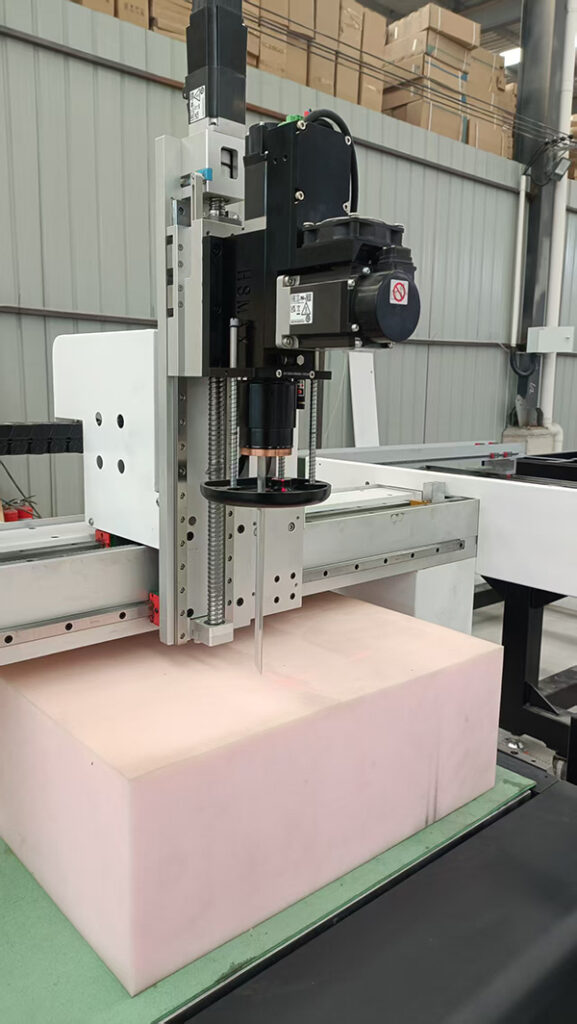High-Frequency Pneumatic Oscillating Tool
Specs at a glance:
- 15,000 vibrations per minute
- 9 mm amplitude
- Built-in pressure regulator

This tool gently lowers the impact on the blade when entering hard materials — meaning less breakage and longer blade life.
It shines when cutting high-hardness materials up to 5 mm thick.
✅ Best for:
- Non-asbestos gaskets
- Graphite reinforced sheets
- PTFE (Teflon) sheets
- Modified PTFE with metal or filler layers
400 W High-Power Electric Oscillating Tool (Servo Type)
Specs:
- 5 mm amplitude
- 4,000 vibrations/min
- Driven by a powerful Mitsubishi servo motor

When your gasket is 8–15 mm thick and made of dense rubber, this tool gives you strong, steady cutting power.
Unlike low-power tools, it won’t “jam” or lose vibration under pressure.
✅ Best for:
- High-density rubber
- EPDM, NBR, or silicone rubber sheets
400 W Electric Oscillating Tool (Large-Amplitude Version)
What’s different?
Same servo motor, but amplitude increased to 10 mm.
That means less resistance, deeper penetration, and smoother cuts for thicker rubber.

✅ Best for:
- 20–30 mm thick rubber gaskets
- Soft composite gasket materials
High-Speed Milling Cutter Tool
Sometimes oscillating blades can’t do everything.
When you need to cut hard boards or drill small holes, the milling cutter takes over.
For high-hardness insulation boards
If you’re cutting epoxy resin, fiberglass, or other insulation plates (3–8 mm thick), choose the milling cutter.
For small or oval holes in thick materials
As thickness and hardness increase, oscillating knives lose efficiency in small-diameter cuts — and blade tips may chip.
Use the milling cutter for small holes and precise shapes.
| Material | Thickness | Hole Diameter | Recommended Tool |
|---|---|---|---|
| Non-asbestos / PTFE | 5 mm | < 5 mm | Milling cutter |
| Rubber sheet | 6–15 mm | < 10 mm | Milling cutter |
| Rubber sheet | 15–25 mm | ≈ 20 mm | Milling cutter |
Small-Power High-Frequency Electric Oscillating Tool
Vibration: 16,000/min
For: Low-density or lightweight gasket materials

This tool delivers fast, clean cuts for thin materials — giving smooth edges and no burning marks.
✅ Best for:
- 5 mm graphite
- 10 mm ceramic fiber paper
- 1 mm or thinner non-asbestos sheets
🧾 Quick Selection Table
| Material Type | Thickness | Recommended Tool | Reference Video |
|---|---|---|---|
| Non-asbestos / PTFE / Graphite | ≤ 5 mm | High-Frequency Pneumatic | Non-asbestos cutting |
| Rubber (High Hardness) | 8–15 mm | 400 W Electric (Servo) | Rubber gasket cutting |
| Rubber (Thick / Soft) | 20–30 mm | 400 W Large-Amplitude | 25 mm Rubber cutting |
| Epoxy / Insulation Board | 3–8 mm | Milling Cutter | Epoxy board cutting |
| Graphite / Ceramic Fiber Paper | ≤ 10 mm | Small-Power High-Frequency Electric | Graphite paper cutting |
💬 Final Words from an AMOR CNC Engineer
Don’t stress over terms like frequency or amplitude.
Just tell us three things:
- What material you cut
- How thick it is
- Whether it’s soft or hard
We’ll configure the right tools for you — guaranteed.
No overthinking, no broken blades, just perfect gaskets every time.
Remember: The right tool = clean edges, longer blade life, and higher efficiency.



